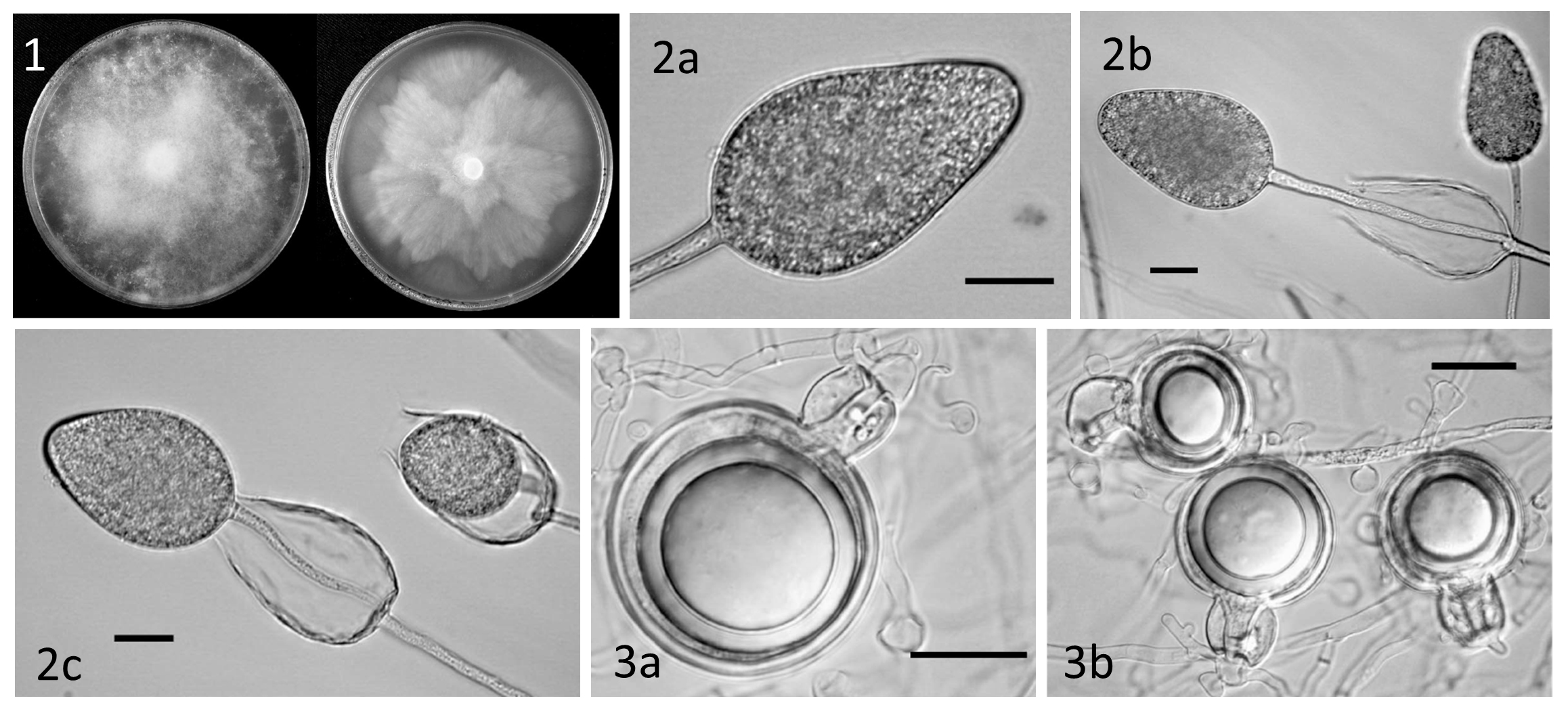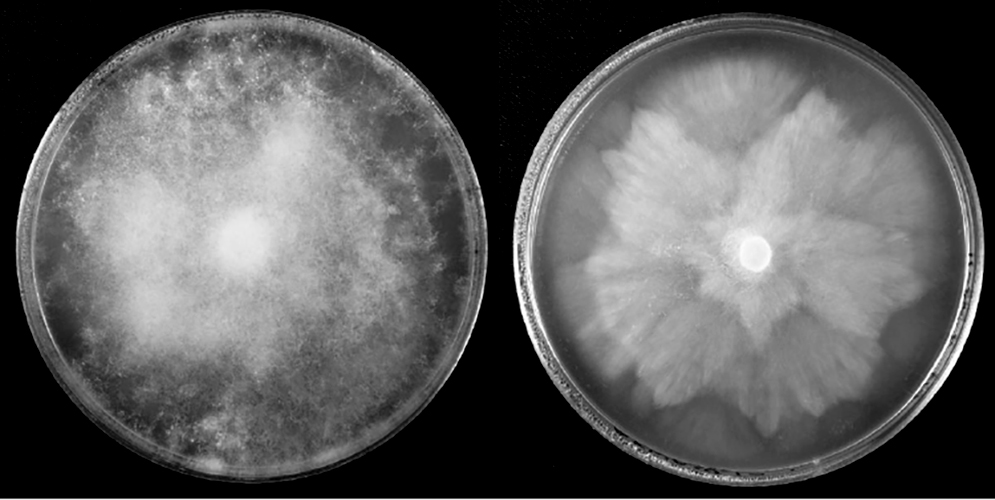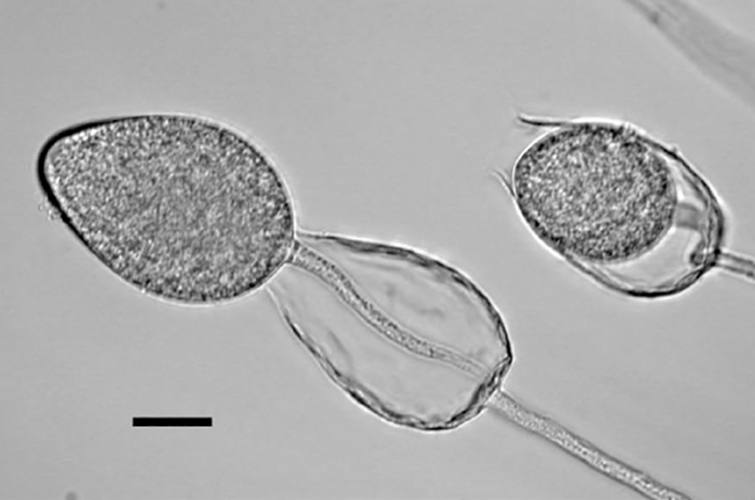Phytophthora borealis
|
Phytophthora spp. in subclade 6b: portion of the seven-loci ML phylogeny featuring the type cultures of 212 described species (by T. Bourret). Notice the position of P. borealis Ex-type CBS 132023 = S&T BL 93. Gloria Abad, USDA S&T.
|
|
Phytophthora spp. in subclade 6b: Morphological Tabular key (PDF) and Tabular key legends (PDF) in IDphy2 KEY SECTION. Notice the data of P. borealis Ex-type CBS 132023 = S&T BL 93. Gloria Abad, USDA S&T.
|
|
Phytophthora borealis asexual and sexual phases of the ex-type: (a) isolate AKWA58.1-0708 on V8S (left) and CA (right) at 15 days, (2a-c) semipapillate persistent sporangia (2b,2c) with external proliferation, (3a-3b) oogonia, amphigynous antheridia and oospores formed by isolate AKWA 72.3-0708 when paired with A2 tester of P. cryptogea; Scale bars = 20μm; photos by Hansen et al 2012. |
|
Phytophthora borealis cultures of the ex-type: isolate AKWA58.1-0708 on V8S (left) and CA (right) at 15 days; photo by Hansen et al 2012. |
|
Phytophthora borealis asexual phase of the ex-type: nonpapillate persistent sporangia with internal proliferation; Scale bar = 20μm; photos by Hansen et al 2012. |
|
Phytophthora borealis asexual phase of the ex-type: nonpapillate persistent sporangium; Scale bar = 20μm; photos by Hansen et al 2012. |
|
Phytophthora borealis sexual phase of the ex-type: oogonium, amphigynous antheridium and oospore formed by isolate AKWA 72.3-0708 when paired with A2 tester of P. cryptogea; Scale bar = 20μm; photo by Hansen et al 2012. |
|
Phytophthora borealis asexual phase of the ex-type: nonpapillate persistent sporangia with internal proliferation; Scale bar = 20μm; photos by Hansen et al 2012. |
|
Phytophthora borealis sexual phase of the ex-type: oogonia, amphigynous antheridia and oospores formed by isolate AKWA 72.3-0708 when paired with A2 tester of P. cryptogea; Scale bar = 20μm; photo by Hansen et al 2012. |
Name and publication
Phytophthora borealis E.M. Hansen, W. Sutton & Reeser (2012)
Hansen EM, Reeser PW, and Sutton W. 2012. Phytophthora borealis and Phytophthora riparia, new species in Phytophthora ITS Cladeclade:
a taxonomic group of organisms classified together on the basis of homologous features traced to a common ancestor
6. Mycologia 104: 1133–1142.
Corresponding author: hansene@science.oregonstate.edu
Nomenclature
from Hansen et al. (2012)
Mycobank
Etymology
“Borealis” references the northern latitudes from which the species was identified.
Typification
Type: UNITED STATES OF AMERICA, Alaska, from Bear Creek, Alaska, N63.61533, W-143.98484, isolated Jun 2008, OSC 144,115, dried culture from OSU AKWA58.1-0708
Ex-type: MYA-4881 & CBS 132023 cultures from OSU AKWA58.1-0708
Sequences for ex-type in original manuscript: Phytophthora borealis isolate OSU AKWA58.1-0708 = ITS HM004232, COX2-COX1 JQ626586, COX1 JQ626625, β -Tubulin JQ626615
Ex-type in other collections
(ET) CBS 132023, ATCC MYA-4881, WPC P19794, AKWA58.1-0708, S&T BL 93 (Abad), 60B2 (Hong)
Molecular identification
Voucher sequences for barcoding genes (ITS rDNA and COI) of the ex-type (see Molecular protocols page)
Phytophthora borealis isolate AKWA58.1-0708 = ITS rDNA HM004232
Phytophthora borealis isolate CPHST BL 93 ( = P19794 ) COI MH136854
Voucher sequences for Molecular Toolbox with seven genes (ITS, β-tub, COI, EF1α, HSP90, L10, and YPT1
(see Molecular protocols page) (In Progress)
Voucher sequences for Metabarcoding High-throughput Sequencing (HTS) Technologies [Molecular Operational Taxonomic Unit (MOTU)]
(see Molecular protocols page) (In Progress)
Sequences with multiple genes for ex-type in other sources
- NCBI: Phytophthora borealis CPHST BL 93
- NCBI: Phytophthora borealis OSU AKWA58.1-0708
- NCBI: Phytophthora borealis MYA-4881
- EPPO-Q-bank: Phytophthora borealis
- BOLDSYSTEMS: Phytophthora borealis (barcoding COI & ITS)
Position in multigenic phylogeny with 7 genes (ITS, β-tub, COI, EF1α, HSP90, L10, and YPT1)
Clade 6b
Morphological identification
adapted from Hansen et al. (2012)
Colonies and cardinal temperatures
Colony colony:
assemblage of hyphae which usually develops form a single source and grows in a coordinated way
pattern on CA angular and petaloid, with appressed hyphaehyphae:
single, tubular filament of a fungal or oomycete thallus; the basic structural unit of a fungus or oomycete
. On V8-A with petaloid pattern. Optimum growth temperature 20°C, maximum 33°C.
Asexual phase
SporangiaSporangia:
sac within which zoospores form, especially when water is cooled to about 10°C below ambient temperature; in solid substrates, sporangia usually germinate by germ tubes
nonpapillatenonpapillate:
pertaining to the production of a non-distinct, or inconspicuous, papilla at the distal end of the sporangium (cf. papillate and semipapillate)
; persistentpersistent:
pertaining to sporangia that remain attached to the sporangiophore and do not separate or detach easily (cf. caducous)
; ovoidovoid:
egg-shaped, with the widest part at the base of the sporangium and the narrow part at the apex
or obpyriformobpyriform:
inversely pear-shaped, i.e. with the widest part at the point of attachment (cf. pyriform)
with a slight apical thickening (59–79 µm long ) showing internal, nested, and extended proliferationextended proliferation:
a type of internal proliferation in which the sporangiophore originates from inside of an empty sporangium, and continues to grow through and out of the old sporangium
originated in unbranched sporangiophores. Hyphal swellings absent. ChlamydosporesChlamydospores:
an asexual spore with a thickened inner wall that is delimited from the mycelium by a septum; may be terminal or intercalary, and survives for long periods in soil
absent.
Sexual phase
Self-sterile. No oogoniaoogonia:
the female gametangium in which the oospore forms after fertilization by the antheridium
were observed in single-strain cultures. One isolate formed oogoniaoogonia:
the female gametangium in which the oospore forms after fertilization by the antheridium
only rarely when paired with an A2 tester isolate of P. cryptogea.
Most typical characters
Phytophthora borealis is similar to Phytophthora gonapodyides and some other sterile Cladeclade:
a taxonomic group of organisms classified together on the basis of homologous features traced to a common ancestor
6 species in the self-sterile character of the sexual phase, although colonycolony:
assemblage of hyphae which usually develops form a single source and grows in a coordinated way
growth pattern and optimum temperature is distinctive for P. borealis.
Additional specimen(s) evaluated
Phytophthora borealis CPHST BL 93 (Abad) = P19794 [World Phytophthora Collection (WPC) California, USA] duplicate of ex-type MYA-4881
Hosts and distribution
Distribution: USA: Alaska
Substrate: stream baits
Disease note: Phytophthora borealis is found in stream water, however, no disease has been found in adjacent riparian ecosystems.
Hosts: n/a
Retrieved January 29, 2018 from U.S. National Fungus Collections Nomenclature Database.
Additional references and links
- SMML USDA-ARS: Phytophthora borealis
- EPPO Global Database: Phytophthora borealis
- Forest Phytophthoras of the world: Phytophthora borealis
- CABI Digital Library: Phytophthora borealis
- Encyclopedia of Life (EOL): Phytophthora borealis
- Index Fungorum (IF): Phytophthora borealis
- Google All Phytophthora borealis
- Google Images Phytophthora borealis
- Google Scholar Phytophthora borealis
Fact sheet author
Z. Gloria Abad, Ph.D., USDA-APHIS-PPQ-S&T Plant Pathogen Confirmatory Diagnostics Laboratory (PPCDL), United States of America.








